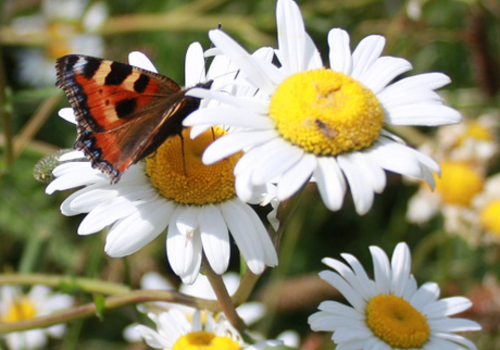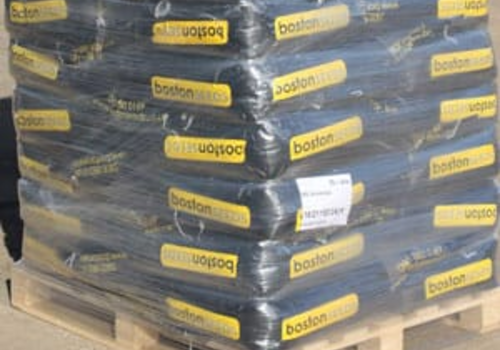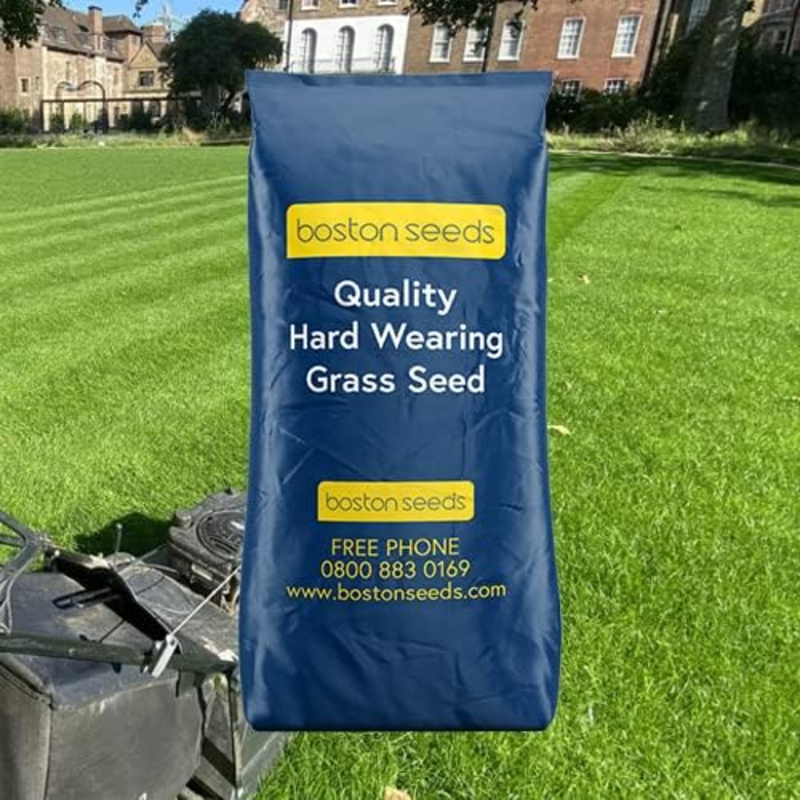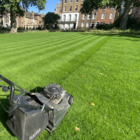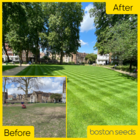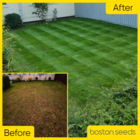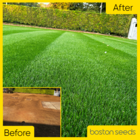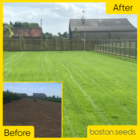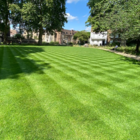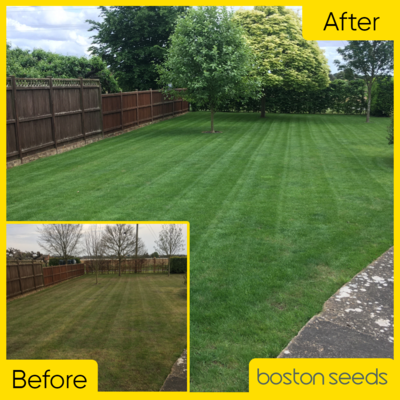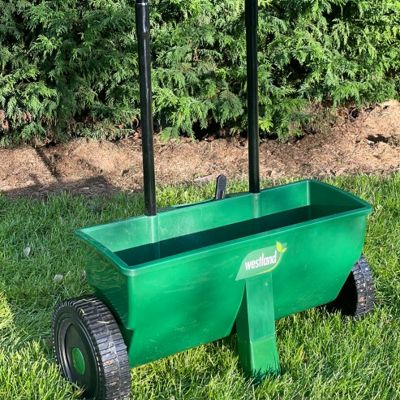BS Quality Hard Wearing Lawn Seed
BS Quality Hard Wearing Lawn Seed is perfect for high-use and high-wear lawns - capable of withstanding the rough and tumble of family life. Whether you have children, pets or both, this grass seed will create the perfect family-friendly lawn. This grass seed mix contains varieties with superior wear tolerance, keeping your lawn looking great even after long summer barbecues or continuous wear from children and pets.
- Easy to establish year-round and suitable for most soil types.
- Utilises the toughest varieties, tested and recommended by the Sports Turf Research Institute (STRI).
- Recovers quickly from the stress and wear (images are all real results from BS Quality Hard Wearing Lawn Seed).
- Contains: 80% amenity perennial ryegrass and 20% strong creeping red fescue.
- DEFRA-certified for exceptionally high purity and germination.
- Sow at 50 grams per sq/m - 20kg covers 400sq/m.
- For best results, use with Pre-Seeding Fertiliser and a spreader.
Mixture Specification
Hard Wearing Grass Seed Mixture Specifications
BS Quality Hard Wearing Lawn Seed utilises grass species and varieties to deliver extreme stress-tolerance and rapid recovery from wear and tear – perfect for back lawns and areas of high usage.
80% Dwarf Amenity Perennial Ryegrass
- Varieties selected from the Sports Turf Research Institute’s recommended list for wear-tolerance and recovery from stress.
- High shoot density, fine-leaved and year-round colour.
- Quick to establish, long-lasting and hard-wearing.
20% Strong Creeping Red Fescue
- Versatile creeping fescue species to complement the rapid-growing Perennial Ryegrass.
- Horizontal, creeping growth suppresses weeds and ensures a thick, tough and resilient sward.
Sowing & Establishment
How to sow a new lawn with hard wearing grass seed
1 - Clear the area
Clear the area and remove any stones, weeds and other debris.
2 - Improve the soil
Cultivate the area to a depth of 15cm and remove any debris that is unearthed. For heavy clay soils, optionally, mix in sharp sand.
3 - Create a level seed bed
Level and rake over the area. Use a lawn roller to firm the soil, if required.
4 - Allow the soil to settle
If possible, leave the soil for a week to allow a flush of weeds to come through; remove before sowing.
5 - Final ground preparation
Rake the area to loosen the top layer of soil. Apply our Pre-Seeding Lawn Fertiliser and rake into the soil.
6 - Sowing the grass seed
Spread the grass seed evenly across the area at 50g/sqm. A spreader can be used for accurate application.
7 - Rake and roll
This step is essential for successful establishment. Gently rake over the area again to incorporate the seed into the top 1-2cm of the soil, so that there is very little seed still visible on the surface. Then lightly roll or tread the seeds in to ensure good seed-to-soil contact. A harrow can be used for large areas.
8 - Water
If going through a period of drought, water the area every other evening for the first few weeks. If regular rainfall, manually watering will not be necessary.
9 - Mowing the lawn
Under optimum conditions, the seed should germinate within approximately 10-14 days. Once it reaches 3-4 inches, cut the lawn for the first time, gradually lowering the height with each subsequent cut as desired.
How to repair an existing lawn with hard wearing grass seed
1 - Prepare the grass
Cut the existing grass short and almost scalp the lawn with the lawn mower. Remove any dead grass, debris and thatch.
2 - Improve the soil
Scarify or rake the surface to loosen the top layer.
3 - Aerate the lawn
Optionally, to aid drainage, use a garden fork or aerator to create small holes of around 1-2 inches deep.
4 - Sow the grass seed
Spread the grass seed evenly across the area at a minimum of 25g/sqm. A spreader can be used for accurate application.
5 - Rake and roll
This step is essential for successful establishment. Gently rake over the area again to incorporate the seed into the top 1-2cm of the soil, so that there is very little seed still visible on the surface. Then lightly roll or tread the seeds in to ensure good seed-to-soil contact. A harrow can be used for large areas.
6 - Water
If going through a period of drought, water the area every other evening for the first couple of weeks. If regular rainfall, manual watering won’t be needed.
7 - Mowing the lawn
Under optimum conditions, the seed should germinate within approximately 10-14 days. Once it reaches a height of 3-4 inches, cut the lawn for the first time, gradually lowering the height with each subsequent cut as desired.
Maintenance
1 - Germination
The best time to sow our Quality Hard Wearing Lawn Seed is from March-October, when the soil temperature is around 8-10 degrees. Under optimum conditions, the seed should germinate within 10-14 days from sowing.
2 - Watering
Grass seed requires warmth, moisture and light to germinate. Typically, autumn will provide more favourable conditions for sowing in terms of moisture, however, if there is a period of drought, manually watering the seeds will be beneficial – this can be done every other evening to allow the moisture to soak into the soil.
3 - Mowing
Allow your lawn to grow to around 3-4 inches in height before cutting your lawn. This can be reduced by half an inch each time until you reach the desired height. An established lawn sown with our Quality Hard Wearing Lawn Grass Seed can be cut as low as 20-40mm. It is important to remove the grass cuttings as dead grass will prevent sunlight from getting to the new grass.
4 - Fertilisation
Regularly fertilising your lawn will provide it with the nutrients it requires to stay lush and green all year-round.
Once the lawn is four months old, you can apply our quick release fertilisers. Dependent on the time of year, choose our Spring and Summer Fertiliser or Autumn and Winter Fertiliser. Around four applications a year, with a minimum of three months between applications will provide sufficient nutrients for an established lawn.
5 - Scarifying, Aerating and Overseeding
Both autumn and spring are good times of year to aerate and scarify your lawn, and tackle any worn areas by overseeding. Aerating your lawn is optional, but particularly useful if you have heavier clay soils where waterlogging may be a problem. Use an aerator or a garden fork to aid drainage. Scarifying is also beneficial in removing any dead grass, moss and thatch that may be hindering the growth of your existing grass.
After this process, there may be some bare patches amongst your lawn – this is the perfect time to overseed when the soil temperature is optimum and moisture is plentiful. We recommend overseeding with the same grass seed mixture as you have previously sown for a uniform appearance.
6 - Controlling Weeds
Unfortunately, as comes with seedbed preparation, weed seeds can lay dormant in the soil and it’s not until they are disturbed and the conditions are ideal, that they then can start to germinate.
If you find that weeds appear during establishment, these will generally be taken out by regular mowing once the lawn has reached around 3-4 inches in height. If the weeds are recurring, after 4 months, a Selective Weedkiller can be applied which will kill common lawn weeds, whilst leaving the existing grass unharmed.
7 – Controlling Moss
Moss can become problematic in areas that are particularly damp and shady. Moss Killer is best applied during March-October when moss is actively growing.
On a newly established area (under 5 months old), avoid using a moss killer as this will be too strong for the lawn. Instead, rake over the area to loosen and remove the moss and add further seed if required.
Once the lawn is established (over 5 months old), a moss killer can be applied such as our Lawn, Feed and Weed plus Moss Killer for light areas of moss, or our Lawn Revivor and Moss Destroyer for more heavily infested areas. After using these, the moss will turn black within a couple of weeks, rake and remove this and overseed with one of our lawn seeds.
FAQs
What is hard wearing grass?
Hard wearing grass is a type of grass that is able to better withstand heavy footfall and other wear and tear - perfect for public areas and also lawns with children and pets.
Typically, hard wearing grass seed mixtures contain perennial ryegrass as this is best for the very toughest applications, such as premiership football pitches, showgrounds, racetracks etc. In more recent years, new varieties of amenity perennial ryegrass have been cultivated to produce finer leaves in order to produce attractive, lush green lawns but still with hard wearing properties.
What are the benefits of choosing hard wearing grass seed?
The main benefits of hard wearing grass seed is its ability to withstand heavy use. It is fast growing and can be used to repair lawn damage quickly and efficiently. With thick roots and strong leaves, it is more resistant to damage.
When is it best to use hard wearing grass seed?
The best time to sow our hard wearing grass or lawn seed is from March-October, when the soil temperature is around 8-10 degrees. Under optimum conditions, the seed should germinate within 10-14 days from sowing.
How to choose the best hard wearing grass seed?
Make sure to buy a hard wearing grass seed from a quality supplier, this ensures that the hard wearing grass seed mixture will contain a high-quality blend of robust grass varieties that are specifically formulated to withstand heavy use.
Buy With Confidence

